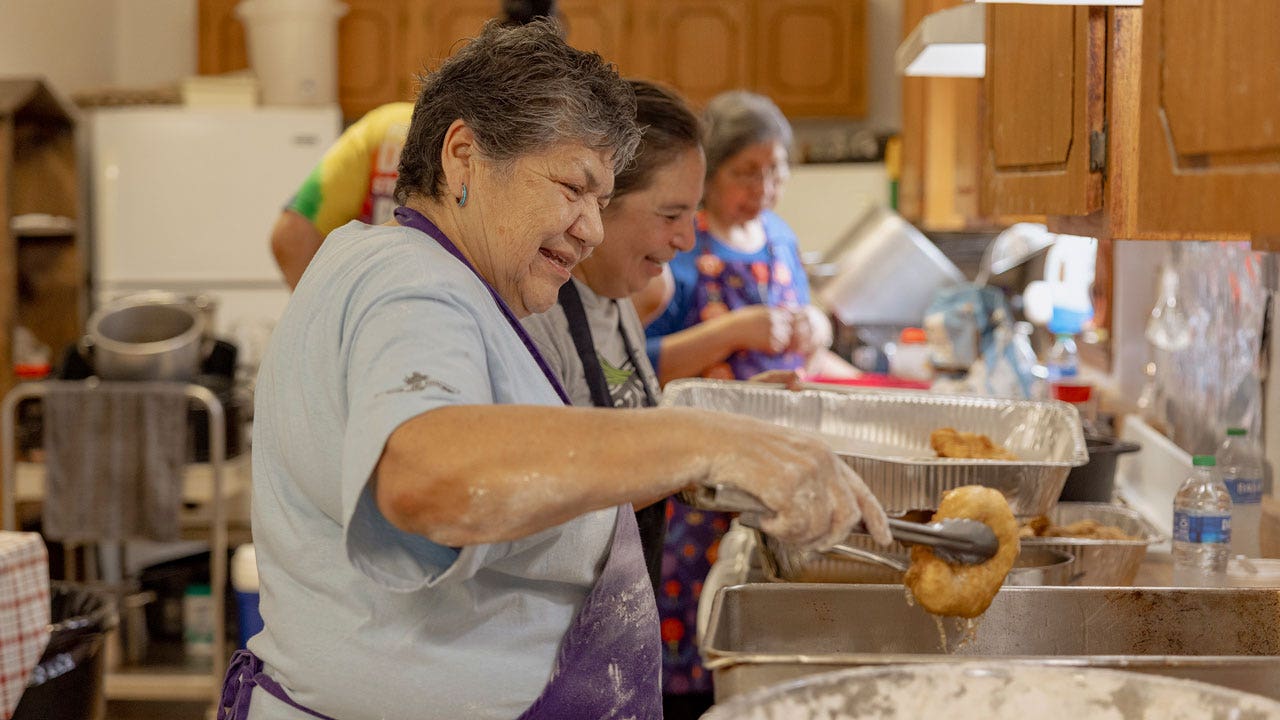Southwest
Cannabis seizures at checkpoints by US-Mexico border frustrate state-authorized pot industry

SANTA FE, N.M. (AP) — The U.S. Border Patrol is asserting its authority to seize cannabis shipments — including commercial, state-authorized supplies — as licensed cannabis providers file complaints that more than $300,000 worth of marijuana has been confiscated in recent months at highway checkpoints in southern New Mexico.
New Mexico’s Democratic governor says the disruptions prompted a discussion this week with U.S. Homeland Security Secretary Alejandro Mayorkas, whose impeachment charges were dismissed this week. Gov. Michelle Lujan Grisham says she voiced concerns that the scrutiny of cannabis companies appears to be greater in New Mexico than states with regulated markets that aren’t along the U.S. border with Mexico.
MARIJUANA USE LINKED TO INCREASED ASTHMA RISK IN YOUTH, SAYS STUDY: ‘WORRISOME’ HEALTH IMPLICATIONS
Authorized cannabis sales in New Mexico have exceeded $1 billion since regulation and taxation of the recreational market began two years ago. Yet cannabis transport drivers say they have been detained hours while supplies are seized at permanent Border Patrol checkpoints that filter inbound traffic for unauthorized migrants and illegal narcotics, typically located about 60 miles (100 kilometers) from the U.S. border.
Traffic crosses from Mexico into the United States at a border station in Santa Teresa, N.M., in this photo taken on March 14, 2012. The U.S. Border Patrol is asserting its right to seize cannabis shipments — including state-authorized commercial supplies — amid complaints of licensed cannabis providers that more than $300,000 worth of marijuana has been confiscated in recent months at Border Patrol highway checkpoints in southern New Mexico. (AP Photo/Jeri Clausing)
“Secretary Mayorkas assured the governor that federal policies with respect to legalized cannabis have not changed,” said Lujan Grisham spokesperson Michael Coleman in an email. “Regardless, the governor and her administration are working on a strategy to protect New Mexico’s cannabis industry.”
Managers at 10 cannabis businesses including transporters last week petitioned New Mexico’s congressional delegation to broker free passage of shipments, noting that jobs and investments are at stake, and that several couriers have been sidelined for “secondary inspection” and fingerprinted at Border Patrol checkpoints.
“We request that operators who have had product federally seized should be allowed to either get their product returned or be monetarily compensated for the losses they’ve sustained,” the letter states.
U.S. Sen. Martin Heinrich said the Department of Homeland Security should be focused on urgent priorities that don’t include cannabis suppliers that comply with state law.
“Stopping the flow of illicit fentanyl into our country should be the Department of Homeland Security’s focus at these checkpoints, not seizing cannabis that’s being transported in compliance with state law,” the senator said in a statement, referring to the parent agency for U.S. Customs and Border Patrol. “New Mexicans are depending on federal law enforcement to do everything they can to keep our communities safe. Our resources should be used to maximize residents’ safety, not distract from it.”
A public statement Thursday from the U.S. Border Patrol sector overseeing New Mexico provided a reminder that cannabis is still a “Schedule 1” drug, a designation also assigned to heroin and LSD.
“Although medical and recreational marijuana may be legal in some U.S. States and Canada, the sale, possession, production and distribution of marijuana or the facilitation of the aforementioned remain illegal under U.S. federal law,” the agency’s statement said. “Consequently, individuals violating the Controlled Substances Act encountered while crossing the border, arriving at a U.S. port of entry, or at a Border Patrol checkpoint may be deemed inadmissible and/or subject to, seizure, fines, and/or arrest.”
Matt Kennicott, an owner of Socorro-based High Maintenance, a cannabis business, said seizures by Border Patrol started in February without warning and create uncertainty about shipments that include samples for consumer-safety testing. He said cannabis producers in southernmost New Mexico rely on testing labs farther north, on the other side of Border Patrol checkpoints, to comply with safeguards against contaminants like mold or pesticides.
“It’s not a little confusing, it’s a lot confusing,” he said. “We’re trying to figure out where this directive came from.”
Read the full article from Here

Los Angeles, Ca
Long Beach declares public health emergency after deadly tuberculosis outbreak

City officials declared a public health emergency Thursday after a tuberculosis outbreak left one person dead and nine others hospitalized.
Health officials said the outbreak stemmed from a group of people who stayed together at a Long Beach hotel room.
As of April 29, 14 cases of tuberculosis (TB) are associated with this outbreak — nine of them required hospitalization and one case was fatal.
Investigators said around 170 people have likely been exposed to the illness. Health officials are in contact with any guests or individuals who were at the hotel during the time the infected people were present.
Tuberculosis is a serious illness that mainly affects the lungs, according to the Centers for Disease Control and Prevention.
The bacteria is spread through the air when an infected person coughs, sneezes or speaks.
“Tuberculosis spreads easily where people gather in crowds or where people live in crowded conditions,” Long Beach health officials said. “People with HIV/AIDS and other people with weakened immune systems have a higher risk of catching tuberculosis than people with typical immune systems.”
“Symptoms of TB disease depend on where in the body the TB bacteria are growing,” the CDC explains. “TB bacteria usually grow in the lungs (pulmonary TB). TB disease in the lungs may cause symptoms such as:
- A bad cough that lasts 3 weeks or longer
- Pain in the chest
- Coughing up blood or sputum (phlegm from deep inside the lungs)
Other symptoms of TB disease include:
- Weakness or fatigue
- Weight loss
- No appetite
- Chills
- Fever
- Sweating at night
Most cases of tuberculosis can be treated with antibiotics. However, those taking medication may need to do so for around six to nine months.
The CDC also notes that not everyone infected with the TB bacteria will become sick. As a result, two TB-related conditions exist — latent TB infection and TB disease.
“People who have been infected but are not yet sick have what’s called latent tuberculosis infection (LTBI),” health officials explained. “People with LTBI can take medication so that they do not later get sick with active TB disease.”
The city’s emergency declaration will “streamline the Department’s ability to quickly secure resources and take additional action to contain the outbreak,” Long Beach officials explained. “The population of concern requires outreach and engagement, necessitating significant staff time to perform multiple interactions. The Department has exhausted their resources to manage this response without an emergency declaration.”
The declaration allows the city to implement preventive measures including:
- Mobilizing City resources
- Accelerating emergency planning
- Streamlining staffing
- Coordinating with other agencies
- Expediting the ability of the City to purchase necessary supplies to identify and treat TB
- Allowing for possible future reimbursement by the State and federal governments
- Raising awareness throughout Long Beach about TB
“The risk of TB for people who live, work, study or visit in Long Beach remains very low,” city officials noted. “The Health Department will continue to screen individuals associated with this outbreak and expects the number of cases and contacts to increase.”
The hotel’s name was not released “to protect patient privacy and comply with HIPAA [Health Insurance Portability and Accountability Act] regulations,” officials said.
More information on tuberculosis can be found on the California Department of Public Health’s website or through the CDC’s website.
Southwest
Oklahoma Native American community sees yearly return of popular wild onion dinners

As winter fades to spring and the bright purple blossoms of the redbud trees begin to bloom, Cherokee chef Bradley James Dry knows it’s time to forage for morels as well as a staple of Native American cuisine in Oklahoma: wild green onions.
Wild onions are among the first foods to grow at the tail end of winter in the South, and generations of Indigenous people there have placed the alliums at the center of an annual communal event. From February through May, there’s a wild onion dinner every Saturday somewhere in Oklahoma.
The bright green stalks of the onions reach a few inches above the dried leaves that crunch under Dry’s feet on a crisp morning in March as he hunts through parks and empty lots near downtown Tulsa. The land he forages straddles the Muscogee Nation and the Cherokee Nation, and he’s thinking of his elisi — grandmother in Cherokee — who taught him how to pick and cook wild onions.
THE GRITS BELT IS AN UNMARKED BUT UNDENIABLE DEMARCATION OF AMERICAN CULINARY CULTURES
“Being able to cook like this, cook the things that my grandmother would cook for strangers, that’s really cool,” Dry explains as he scans the forest floor. He’s careful not to overharvest, taking only what he needs.
“Traditionally, what I grew up with, you just boil them in a little bit of water and then fry them with scrambled eggs,” Dry said.
That’s the way wild onions are typically cooked for large gatherings, a side dish of greens with a familiar peppery bite, served alongside fried pork, beans, frybread, chicken dumplings, cornbread, and safke — a soup made with cracked corn and lye from wood ash that is common among tribal nations in the southeast, including the Muscogee, Chickasaw, Choctaw, Cherokee, and Seminole.
Carol Tiger, a member of Muscogee Nation and an elder at the Springfield United Methodist Church in Okemah, Oklahoma, lets the oil drip off a freshly-cooked piece of frybread at the church’s annual wild onion dinner on April 6, 2024. Wild onions are among the first foods to grow in the spring, and the dinners have been a tradition in Native American communities for generations. (AP Photo/Brittany Bendabout)
Dry likes to mix tradition with contemporary, such as using wild onions to make omelets and kimchi.
“I’ve even used them to create salsa or chimichurri for steaks,” he said.
The following Saturday morning, at least 100 people wait for the tribal community center to open in Okmulgee, the capital of the Muscogee Nation about 40 miles south of Tulsa. For the second consecutive year, the community is gathering for a wild onion dinner to raise travel funds for Claudia McHenry, a tribal citizen hoping to compete at this year’s Miss Indian World Pageant in Albuquerque, New Mexico.
Dozens of people cook and hand out food, there is a silent auction, and a local mekko — a Muscogee spiritual leader — gives the opening welcome.
Over the last several generations, churches in Oklahoma — particularly United Methodist Churches in Native American communities — have used wild onion dinners to raise funds for church bills and annual dues, said Chebon Kernell, a mekko for his community and a UMC clergy member.
“But as the years went by, it became an enormous community event,” he said.
McHenry said seeing the community rally behind her gives her the courage she needs.
“To just see people turn out for me physically,” she said. “It gives me really a lot of good emotions and pushes me and propels me to continue forward toward my goals.”
For the next three hours, hundreds show up and pay $15 for a plate of food to send her down that path. For many, helping McHenry or the local church is the only thing that could improve upon the undeniable allure of hogfry. And in no place is that truer than the Springfield UMC in Okemah, another 35 miles south, the following Saturday.
It isn’t uncommon for people to come from Arkansas, Kansas, or Texas for a piece of that community’s famed fried pork and a heap of wild onions. Some travel that far because they’re part of the Muscogee diaspora. Others simply follow the church’s signs down a dusty gravel road until the canopy of trees opens up to an endless field of waving grass, still copper from the winter’s rest.
For nearly two decades, hundreds have lined up on the porch of the church’s small gathering hall on the first Saturday in April for a plate of food. And every year you’ll find Carol Tiger there, elbow deep in a bowl of frybread mix.
Everyone calls Tiger the head cook.
“I just let them know what we have to do,” she said, sending a wave of laughter through the kitchen.
In past years, Tiger and other church elders would take their grandkids to pick onions, but this year they’re expecting 500 to 600 hungry people, so they purchased their onions cleaned and chopped for $40 a gallon. The families of the church also contribute a gallon each.
Elders tell stories from the rocking chairs on the porch, children play in the woods nearby, and vendors sell beadwork and clothing. The small field around the church has been cut and edged and is full of vehicles with tribal tags from across the state. Men fry pork in a giant pan over a fire outside, while women fill the dining hall with the warmth of home-cooked food.
After clearing their plates, attendees enjoy a piece of cake or a bowl of grape dumplings — a dessert traditionally made from wild grape juice that today is often made with frozen juice and canned biscuits. They stay well into the afternoon, talking and eating, certainly sad when it’s time to go.
But it’s mid-April, and wild onion dinner season isn’t over yet. There’s always next Saturday, a little further down the road.
Read the full article from Here
Los Angeles, Ca
Over 100 arrested in Southern California drug bust operation

Over 100 people were arrested during a massive drug bust operation in Southern California.
The undercover bust targeted the Magnolia Avenue corridor, between Van Buren Boulevard and Pierce Street in Riverside, according to the Riverside Police Department.
The multi-day effort, called “Operation Street Sweeper,” stemmed from “increased criminal activity and complaints from community members and businesses,” police said.
Over a three-week period, 46 people were seen buying a variety of illegal narcotics including methamphetamine, fentanyl, cocaine, PCP and Psilocybin mushrooms.
In a three-day operation, 44 drug dealers were identified and 33 of them were arrested for narcotics sales violations.
With help from nearby agencies, 71 additional suspects were also arrested for multiple charges including:
- 32 misdemeanor arrests were made for trespassing, public intoxication, possession of drug paraphernalia, and illegal possession of controlled substances
- 21 outstanding misdemeanor arrest warrants for shoplifting, petty theft, trespassing, possession of drug paraphernalia, illegal possession of controlled substances, and being under the influence of a controlled substance
- 15 arrests for violation of parole, probation, and post-release community supervision
- 3 outstanding felony arrest warrants
- 3 probation searches were conducted at local motel rooms
- 2 search warrants were served at local residences
A total of 104 people were arrested during the large-scale bust. Most of the people arrested claimed to be homeless or living in various motels along Magnolia Avenue, officers said.
During a probation search of a motel room, police discovered a woman who was wanted for a 2022 felony drunk-driving crash that critically injured two women and a 4-year-old boy.
Inside her motel room was also a man with an outstanding warrant for burglary. Police discovered the man possessed several thousand dollars worth of stolen merchandise as well.
Since the arrests, medical aid and police calls for incidents along the Magnolia Avenue corridor “immediately and significantly decreased as a result,” authorities said.
“This wasn’t a one-and-done operation, and our enforcement efforts will continue until our community members, businesses, and visitors feel a constant sense of safety in Riverside,” said Larry V. Gonzalez, Riverside Police Chief.
“The Riverside Police Department will continue its directed enforcement and efforts to investigate those engaged in the trafficking and sale of illicit drugs within our neighborhoods, amongst other crimes affecting the safety of community members,” the police department said.
The public can submit tips about illegal drug activity by calling Riverside police at 951-354-2007.
Information can also be submitted through the “Atlas 1” mobile app by using the “Send a Message” feature. App downloads for Apple devices can be found here. Android device downloads can be found here.
-

 News1 week ago
News1 week agoLarry Webb’s deathbed confession solves 2000 cold case murder of Susan and Natasha Carter, 10, whose remains were found hours after he died
-

 World1 week ago
World1 week agoHaiti Prime Minister Ariel Henry resigns, transitional council takes power
-

 News1 week ago
News1 week agoFirst cargo ship passes through new channel since Baltimore bridge collapse
-

 World1 week ago
World1 week agoUS secretly sent long-range ATACMS weapons to Ukraine
-

 World1 week ago
World1 week agoSpanish PM Pedro Sanchez suspends public duties to 'reflect'
-

 News1 week ago
News1 week agoAmerican Airlines passenger alleges discrimination over use of first-class restroom
-

 Movie Reviews1 week ago
Movie Reviews1 week agoHumane (2024) – Movie Review
-

 Education1 week ago
Education1 week agoVideo: Johnson Condemns Pro-Palestinian Protests at Columbia University























